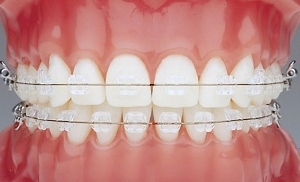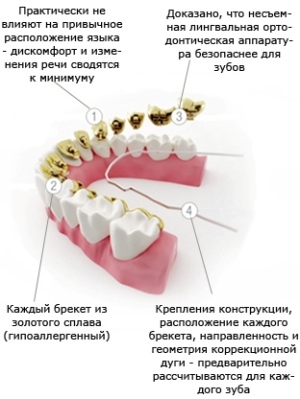 Braces are very widely used in dentistry to repair defects in the dentition. They are used both for aesthetic purposes, and in order to avoid more serious problems with bite.
Braces are very widely used in dentistry to repair defects in the dentition. They are used both for aesthetic purposes, and in order to avoid more serious problems with bite.
These orthodontic devices are installed for both children and adults. In both cases, the correction with the help of bracket systems gives very good results.
The type of brackets to be installed is selected taking into account the patient's preferences and medical indications. The time of wearing the corrective design is strictly individual for each case and depends on a number of factors.
Many patients who decided to install braces are interested in the course of this procedure. Is the attachment of the system to the teeth and its removal painful? How to remove the device? And can it be done without visiting the dental clinic, at home?
Contents of
- How are they installed?
- Installation of the vestibular system
- Stages of installation of the lingual systems
- How many different braces should be worn?
- How much do invisible braces put?
- How do they remove the system?
- Let's turn to knowledgeable people
- FAQ
- Is it painful to put braces?
- Does it hurt to shoot the system?
- Can I remove it myself?
How are they installed?
First of all, the installation process and the time required for this depends on the system chosen by the patient and the physician: lingual or vestibular. The first is placed on the inner surface of the dentition and is almost invisible. The second is attached to the front side of the teeth and is more visible to others.
Installation of the vestibular system
For the installation of the vestibular structure, it is necessary to go through several steps.

Sapphire braces
The preparatory stage includes a primary consultation of an orthodontist, examination and roentgen( MRI) of the oral cavity, treatment of carious lesions and selection of the bracket system. Braces are installed only on healthy teeth.
Therefore, if the patient has tooth decay, then it is subject to compulsory treatment before fixing the orthodontic device.
 This is due to the fact that when correcting bite defects with the help of braces on the dentition there is a significant load.
This is due to the fact that when correcting bite defects with the help of braces on the dentition there is a significant load.
In addition, the installed system makes oral hygiene difficult and promotes the multiplication of various bacteria. Together, these factors can lead to the development of caries, and if it already exists, then aggravate the situation.
Various kinds of gum inflammation are subject to treatment. Some patients are recommended professional cleaning before braces are installed. The locks of the system should be as tightly attached to the surface of the enamel, and the existing plaque prevents this. The duration of the preparatory phase depends entirely on the condition of the patient's teeth and gums.
With the help of a special, very strong adhesive, locks are attached to the surface of each tooth. By its consistency and appearance, it is similar to the material used for sealing. Then the orthodontic arc is attached to the system, due to which the patient's teeth take the desired position.
Installation of the metal system:
The entire procedure takes an average of one and a half hours. In some cases, braces may be installed for up to three hours or more.
Stages of installation of lingual systems
Correction of anomalies of the dentition with the help of lingual devices has a slightly different sequence.
-
 Everything starts, like in the first case, with the treatment of carious formations and inflammations in the oral cavity of the patient .The time it takes depends on the number of affected teeth.
Everything starts, like in the first case, with the treatment of carious formations and inflammations in the oral cavity of the patient .The time it takes depends on the number of affected teeth. - then removes the mold from its jaw, based on which the full-sized model is manufactured. It should be completely analogous to the patient's teeth. This is necessary because lingual braces are created individually for each individual case, taking into account all the features and defects of the occlusion. At this stage it takes from 1 - 2 weeks to a month.
- The third stage is the installation of the system for the patient .Preliminary polishing and treatment( disinfection) of the tooth surface is carried out. Then on the cleared enamel with the help orthodontic glue braces-zamochki are fastened. After each of them an arc is fixed, displacing the teeth in the desired direction.
Installation of lingual braces on the teeth:
Installation of the internal system is more time consuming, therefore the entire procedure is spent from 1.5 to 2 hours to 3, sometimes 5 hours.
How many different braces should I wear?
The timing of wearing braces for aligning the teeth depends on three factors:
-

In the photo the dentition before and after the orthodontic treatment of
the degree of jaw and dental abnormality;
- kind of installed system;
- the age of the patient.
Depending on how much the curvature has a dentition, adults go with bracket systems from 6 months to 3 years. Thus half a year treatment of absolutely insignificant defects lasts.
The correction of more serious anomalies takes at least a year, often this period increases to 2 - 3 years.
How much do invisible braces put?
With the installation of the lingual system, the correction period can be reduced by almost half. The internal system has a stronger effect on the dentition and is created individually for each patient. Therefore, the effect when using it is achieved more quickly.

Affects the wearing time and age of the patient. In children, the process of correction is much faster and more effective than in adults. The older the person, the longer he will have to wear corrective devices to achieve complete bite correction.
How do they remove the system?
The braces are removed in reverse order. Initially, the orthodontist, using dental tweezers, gently, consistently releases the arc from each lock and extracts it. Then the braces( locks) are removed from the teeth with special forceps.
All these actions take an average of 15 to 30 minutes.
After this, the tooth enamel must be cleaned of residues of orthodontic glue. The doctor performs cleaning and polishing of the teeth, which lasts about half an hour. If there are signs of demineralization around the locks, a fluorination or calcination procedure is additionally carried out.
The video shows how to remove the braces from the teeth:
At the request of the patient, teeth whitening can be additionally performed. Taking into account these manipulations to the original time, it will be necessary to add about 30 to 40 minutes.
Let's turn to knowledgeable people
Reviews of patients who have been carried out procedures for removal and installation of braces.
Removing the braces was much faster than installing. The doctor did everything very quickly and neatly. In the dental chair I did not spend more than 40 minutes, after which I got up from it with even and clean teeth.
Ольга, 29 years old, Krasnodar
The installation of braces was decided only in 33 years. The point of "dismantling" the system, frankly, was afraid. After all, braces are very firmly attached to the teeth, and I thought that the process of removal will be long and painful. Contrary to my fears, the procedure was completely painless and fast enough.
Given the removal of the arc, locks, cleaning of teeth from the remains of glue and subsequent fluoridation, I spent a little more than an hour in the clinic. The removal took no more than 20 minutes.
Nikolay, 35, Moscow region
Frequently Asked Questions
 Anyone who decides to fix a jaw or tooth anomaly with braces is concerned with a lot of questions. Usually they are associated with the installation of orthodontic adaptation, its wearing and removal. And this is natural, because the system is rather complicated and is installed for a long time.
Anyone who decides to fix a jaw or tooth anomaly with braces is concerned with a lot of questions. Usually they are associated with the installation of orthodontic adaptation, its wearing and removal. And this is natural, because the system is rather complicated and is installed for a long time.
Most of the patients are interested in whether they will experience pain when installing and removing the bracket system? And how does the procedure for releasing the dentition from the corrective apparatus occur?
Is it painful to put braces?
The procedure for installing the system is quite long and painstaking, but completely painless. Discomfort can occur only during mechanical cleaning and polishing of the enamel, because some teeth are sensitive enough. After fixing the orthodontic arch, there will be noticeable pressure, because it pushes the teeth in the right direction. But all these sensations can not be called pain, in addition, they disappear completely after a while.
Is it painful to remove the system?
Braces are also removed painlessly. The orthodontist gradually, gently releases the patient's teeth from the elements of the system. Removal takes place faster than installation.
Despite the fact that the locks are attached to the teeth with a very strong adhesive, they are removed very easily, without the use of force and pain.
Can I remove it myself?
Removing brackets is a very painstaking procedure that requires a certain amount of accuracy, tools and skills. Therefore, it is impossible to remove the system independently, without the help of a specialist. Ideally, the corrector should be removed by the same doctor who was installing it. After all, he is well acquainted with the features of the patient's dental rows and the braces system.
But such fears are absolutely groundless and have no basis. Mounting and removal of the construction is absolutely painless, and the result of correction will please the patient very, very long!
